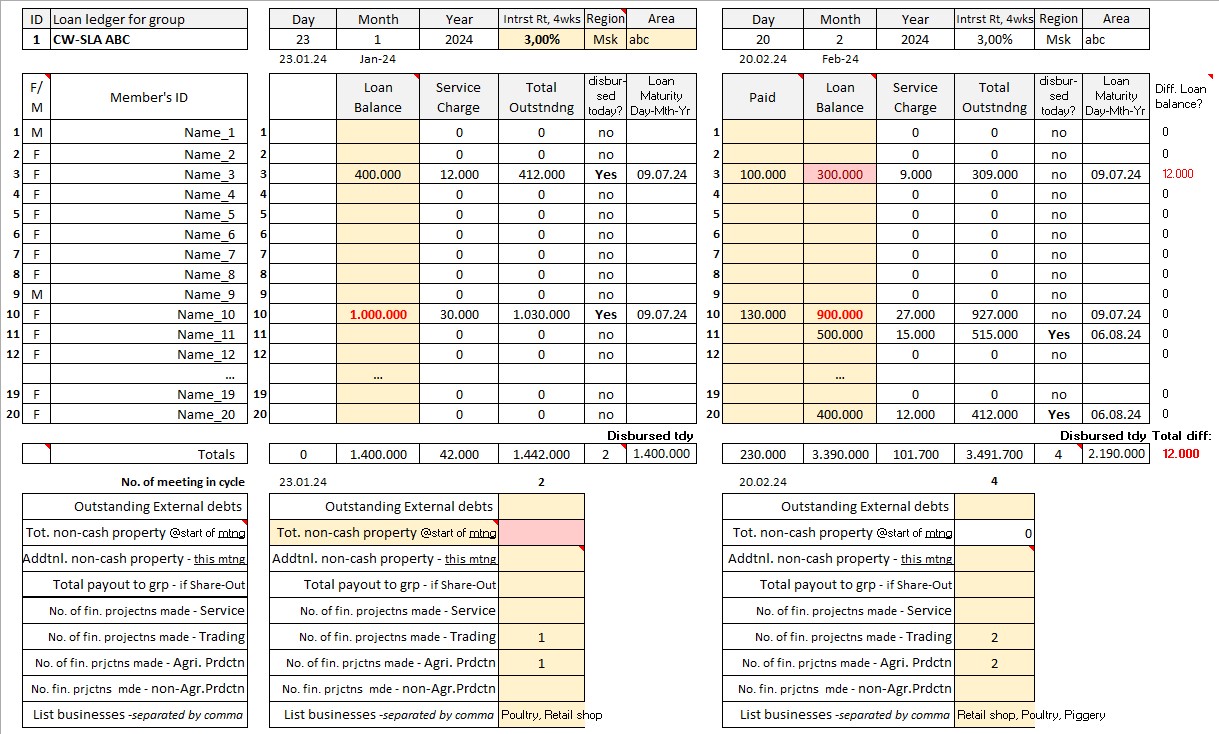|
Projects > Uganda_CWM: Sep12-Jun19 &
Nov19-today
|
|
|
|
The Ugandan
Catholic Workers Movement (CWM), a country-wide-wide operating social
& church association has been founded in 1995 in the diocese Masaka and
is now active in 12 out of the 19 dioceses. Each CWM member belongs to one
Base Group on primary level. The groups are supported through voluntary
Diocesan Executive Committees (DEXCOs) on secondary level and a voluntary
National Executive Committee (NEXCO) on tertiary level. Since 2013 between
10 -20 members within one Base Group each can form a Catholic Workers
Raiffeisen-Savings & Loan Association (CW R-SLA) as soon as an in-house
CW-trainer is available.
The members save bi-weekly and take or repay loans every four weeks from the savings plus retained earnings fund following
|
strict rules as in Village SLAs (www.vsla.net). The original VSLA methodology has been slightly adjusted and enhanced with the following fundamental principles. A county-wide three-level
network of CW Raiffeisen-SLAs featuring:
·
Monthly internal audit, self-monitoring & evaluation on all three levels
·
Business
financial-planning for each loan request
·
Linkage Banking with Centenary
Bank Uganda
·
Measurable
services paid for by the groups
·
Regional trainings of CW R-SLA trainers and internal auditors by the coordinator on tertiary level
|
|
 
|
|
The federation
is built in analogy to the DGRV-German Cooperative and Raiffeisen
Confederation
|
|

Monitoring of 1st generation of trainers
|

Training of 1st generation of Analysts =
Auditors
|
|
|
|
|

|
I.
The Deputy record-keeper copies entries from pass-books and notebook (loan fund at hand & bank, ...) into the group’s digital* savings- & loan ledgers and sends it to the regional R-SLA Support Team
II.
If needed regional team corrects mistakes
high-lighted in the digital
ledger and reads financial & business report into Regional Aggregation Tool
III.
R-SLA coordinator establishes the internal audit report on tertiary
level from all the regional reports submitted.
*See Recent Developments below:
If deputy
record keeper owns a smartphone, she/he copies the hand-written ledger
entries into its simple electronic version from where the
internal auditor reads them into the “Digital Ledger” with automated audit features and financial reports.
|
|
|
Business
financial-planning is taught by the CW-SLA trainer with the Cost-Income Template of the Financial
Projections Tool which is based
on unit pricing. The group learns how to quantify each item needed for a
new/enhanced business. The members internalize the concepts through continuous application of the tool for each loan request. This self-learning process will more and more empower people at the
grass root in financial and business affairs.
|
|
|

|

|
|
|
A CW-SLA member presents his costs-income
projections to receive a
loan for his new business idea. All others reflect together, if the individual assumptions are realistic and if so
approve the loan.
|
Pilot training:
All costs and in particular the income are
estimated in the cost-income template of the financial projections tool
|
|
|
|
|
|
RECENT
& ONGOING DEVELOPMENTS
The three-level internal audit,
self-monitoring & evaluation system was now also digitised at the primary
level. For this the manual-written group ledgers were enhanced with an
Excel based digital ledger with fully
automated audit features and financial reports.
The Digital-Ledger is comprised out of a sheet each for all
members' flows on savings & loans including the loan fund balances, a
template for the share-out calculations as well as the monthly financial
statements over an entire group cycle ~ one year.
In case that the deputy record keeper owns a
smartphone, she/he copies the manual ledger entries into the electronic
template for the ledgers from where the internal auditor reads them into
the Digital Ledger. In the future the deputy record keeper might directly
use the Digital-Ledger.
|
|
Savings Sheet

|
|
|
All
white cells are calculated by the tool. Golden cells are to be filled by
the user. User cells appearing in red indicate a mistake.
Cell comments suggest how to possibly resolve the respective error.
|
|
|
Loan sheet

|
|
|
Share-out Template for
automated calculations

|
|
|
Remote Monitoring &
Evaluation on regional level: The regional supervisor
·
Reads the Digital-Ledgers
of all existing R-SLAs in the region into the Regional Aggregation Tool
·
Checks in the resulting Regional
Report if there is any error
marked in red, not yet resolved by the internal auditors.
·
Analyses the performance
of each SLA by reading the graphs of key performance indicators over time.
This information enables him to better advise the
SLA to take the group to the next level.
|
|
|
Graphs of the group’s Key Performance Indicators over time
Cycle 9-12 of an R-SLA with 20
members and 3% interest rate on 4-weekly basis


|
|
From all regional reports submitted, the R-SLA
coordinator establishes the Internal
Audit Report on Tertiary Level:

|
|
|
|
|
|
|